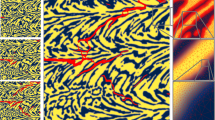Abstract
The accurate and efficient prediction of the interaction of microcracks with macrocracks has been a challenge for many years. In this paper a discretization error controlled adaptive multiscale technique for the accurate simulation of microstructural effects within a macroscopic component is presented. The simulation of cracks is achieved using the corrected XFEM. The error estimation procedure is based on the well known Zienkiewicz and Zhu method extended to the XFEM for cracks such that physically meaningful stress irregularities and non-smoothnesses are accurately reflected. The incorporation of microstructural features such as microcracks is achieved by means of the multiscale projection method. In this context an error controlled adaptive mesh refinement is performed on the fine scale where microstructural effects may lead to highly complex mechanical behavior. The presented method is applied to a few examples showing its validity and applicability to arbitrary problems within fracture mechanics.
Similar content being viewed by others
References
Belytschko T, Black T (1999) Elastic crack growth in finite elements with minimal remeshing. Int J Numer Methods Eng 45: 601–620
Bordas S, Duflot M (2007) Derivative recovery and a posteriori error estimate for extended finite elements. Comput Methods Appl Mech Eng 196: 3381–3399
Bordas S, Duflot M, Le P (2008) A simple error estimator for extended finite elements. Commun Numer Methods Eng 24(11): 961–971
Duflot M, Bordas S (2008) A posteriori error estimation for extended finite elements by an extended global recovery. Int J Numer Methods Eng 76(8): 1123–1138
Fries T (2008) A corrected xfem approximation without problems in blending elements. Int J Numer Methods Eng 75: 503–532
Fries T, Belytschko T (2010) The extended/generalized finite element method: an overview of the method and its applications. Int J Numer Methods Eng 84: 253–304
Fries T, Byfut A, Alizada A, Chang K, Schröder A (2011) Hanging nodes and xfem. Int J Numer Methods Eng 86: 404–430
Gerasimov T, Rüter M, Stein E (2012) An explicit residual-type error estimator for q 1-quadrilateral xfem in 2d lefm. Int J Numer Methods Eng 90: 1118–1155
Gerstenberger A, Wall WA (2008) An eXtended finite element method/Lagrange multiplier based approach for fluid—structure interaction. Comput Methods Appl Mech Eng 197: 1699–1714
Guidault PA, Allix O, Champaney L, Cornuault C (2008) A multiscale extended finite element method for crack propagation. Comput Methods Appl Mech Eng 197: 381–399
Jayaswal K, Grosse IR (1993) Finite element error estimation for crack tip singular elements. Finite Elem Anal Des 14: 17–35
Kim D, Pereira J, Duarte C (2010) Analysis of three-dimensional fracture mechanics problems: a two-scale approach using coarse-generalized fem meshes. Int J Numer Methods Eng 81: 335–365
Legay A, Chessa J, Belytschko T (2006) An Eulerian–Lagrangian method for fluid—structure interaction based on level sets. Comput Methods Appl Mech Eng 195: 2070–2087
Loehnert S, Belytschko T (2007a) Crack shielding and amplification due to multiple microcracks interacting with a macrocrack. Int J Fract 145: 1–8
Loehnert S, Belytschko T (2007b) A multiscale projection method for macro/mircocrack simulations. Int J Numer Methods Eng 71: 1466–1482
Loehnert S, Mueller-Hoeppe D (2008) Multiscale methods for fracturing solids. In: Reddy B (ed) IUTAM symposium on theoretical, computational and modelling aspects of inelastic media, IUTAM bookseries. Springer, Berlin, pp 79–87
Loehnert S, Mueller-Hoeppe D, Wriggers P (2011) 3D corrected XFEM approach and extension to finite deformation theory. Int J Numer Methods Eng 86: 431–452
Melenk JM, Babuška I (1996) The partition of unity finite element method: basic theory and applications. Comput Methods Appl Mech Eng 139: 289–314
Moës N, Dolbow J, Belytschko T (1999) A finite element method for crack growth without remeshing. Int J Numer Methods Eng 46: 131–150
Panetier J, Ladevèze P, Chamoin L (2010) Strict and effective bounds in goal-oriented error estimation applied to fracture mechanics problems solved with xfem. Int J Numer Methods Eng 81: 671–700
Pereira J, Kim D, Duarte C (2012) A two-scale approach for the analysis of propagating three-dimensional fracture. Comput Mech 49: 99–121
Prange C, Loehnert S, Wriggers P (2012) Error estimation for crack simulations using the xfem. Int J Numer Methods Eng. doi:10.1002/nme.4331
Ródenas JJ, González-Estrada OA, Tarancón JE, Fuenmayor FJ (2008) A recovery-type error estimator for the extended finite element method based on singular + smooth stress field splitting. Int J Numer Methods Eng 76: 545–571
Rose LRF (1986) Microcrack interaction with a main crack. Int J Fract 31: 233–242
Rubinstein AA (1986) Macrocrack-microdefect interaction. J Appl Mech 53: 505–510
Stolarska M, Chopp DL, Moës N, Belytschko T (2001) Modelling crack growth by level sets in the extended finite element method. Int J Numer Methods Eng 51: 943–960
Strouboulis T, Copps K, Babuška I (2001) The generalized finite element method. Comput Methods Appl Mech Eng 190: 4081–4193
Strouboulis T, Zhang L, Wang D, Babuška I (2006) A posteriori error estimation for generalized finite element methods. Comput Methods Appl Mech Eng 195: 852–879
Sukumar N, Chopp DL, Moës N, Belytschko T (2001) Modeling holes and inclusions by level sets in the extended finite-element method. Comput Methods Appl Mech Eng 190: 6183–6200
Tamuzs VP, Petrova VE (2002) On macrocrack-microdefect interaction. Int Appl Mech 38: 1157–1177
Wu CC, Rice RW, Becher PF (1981) The character of cracks in fracture toughness measurements of ceramics. Fract Mech Methods Ceram Rocks Concr ASTM STP 745: 127–140
Zienkiewicz OC, Zhu JZ (1987) A simple error estimator and adaptive procedure for practical engineering analysis. Int J Numer Methods Eng 24: 337–357
Author information
Authors and Affiliations
Corresponding author
Rights and permissions
About this article
Cite this article
Loehnert, S., Prange, C. & Wriggers, P. Error controlled adaptive multiscale XFEM simulation of cracks. Int J Fract 178, 147–156 (2012). https://doi.org/10.1007/s10704-012-9777-0
Received:
Accepted:
Published:
Issue Date:
DOI: https://doi.org/10.1007/s10704-012-9777-0




